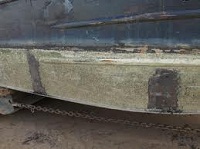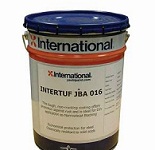.: How to black your narrowboat
When blacking a narrow boat, your going to get covered in bitumen. Don't worry, there is a proven liquid that removes it. Canal water.
 Slipping your craft
Slipping your craft
Ideally you do your blacking in the summer, but if not you will need a covered dock......... I don't like dry docks, they are too damp, but they are cheap. Its up to you and it depends a lot on what you have close. The ideal situation is above ground in July! I book mine in 7-8 months in advance. Blacking should be performed at 24 month intervals and you need to black the entire bottom, not just the sides. With the muck in the water these days a 10mm bottom plate can rot through in 30 years.
 Cleaning
Cleaning
The boat must be examined, cleaned and dried. First walk round, look for shiny bare steel patches, and rusty brown boils, both these show electrolysis. Next jet wash the hull with a real jet wash - hire a diesel one! Now scrape away the white residue along the waterline, do not use a wire brush, it will stop the blacking sticking. Leave to dry, If possible, for 48 hours. A trick is to run your boats heating flat out, it helps a lot as it heats the steel from inside.
 Blacking choice
Blacking choice
You really have two choices, Intertuf 16 or bitumen paint. I have always used international intertuf, but at £140 for 20 litres its expensive. My friend and I slip one after each other, he uses bitumen...... A year later there is no real difference. Check out intertuf prices
 First blacking coat
First blacking coat
For the first coat, heat a 5 litre can of gunge in a pot of boiling water till its thin. Keep it hot and put on a medium coat all over. Now leave for 24 hours to dry. This thin coat should get into all the crevices.... and help the blacking stick.
 Main blacking
Main blacking
Now apply two coats of blacking (unheated), leaving 24 hours between applications. Pay special attention to the underneath of rubbing strakes - i like to pack blacking under the strips as they are open at the bottom
 Drying
Drying
Allow the blacking to dry for 48 hours before returning to the water.
 Marina's
Marina's
The section above is how it should be done, a marina does it somewhat differently....... your lucky if they don't put you back the day you came out......... anyway, some tips to help get a better job are - hover around while they work, (tell them you want to see the condition of the bottom) and the moment you see them painting bitumen over wet steel, complain. Again, run your heating at max the entire time its out of the water. .
 Costs
Costs
NEVER EVER let ANY marina touch your boat without a written quote. I wanted a small over plate on my counter and got a price from XXXX boat yard. The price was £580, the chap was on my boat, he saw the job, and i had a witness with me. Having been stiffed before I questioned the price twice to check everything was included. Apparently it was.... However, In the end the final price was £1200. Another marina charged me double to have my boat lifted out as they had to move another boat they had taken out before..... that quote was in writing, but when the transport lorry is waiting what can you do? Yet another marina charged me for a special cradle they alledgedly needed for slipping my V hull. £50 for a foot of 2"X4" wood...... the list goes on. Quick comment here - Sealand boat delivery service are superb. They moved my Springer for me, and its the only time I have felt confident enough to just drive away and let them get on with it. More stuff got broken by the guy that craned me out, than 250 miles on a lorry. Big thanks to those chaps. If you need you boat moved, look them up on google, it cost me £580 for 250 ish miles.... And the guy that runs it actually knows his stuff - the important things like where to get craned out, or where to hire a crane ..... He arranged my entire move - one payment, no hastle, job done. They have some great pictures on there site too! www.btx.co.uk